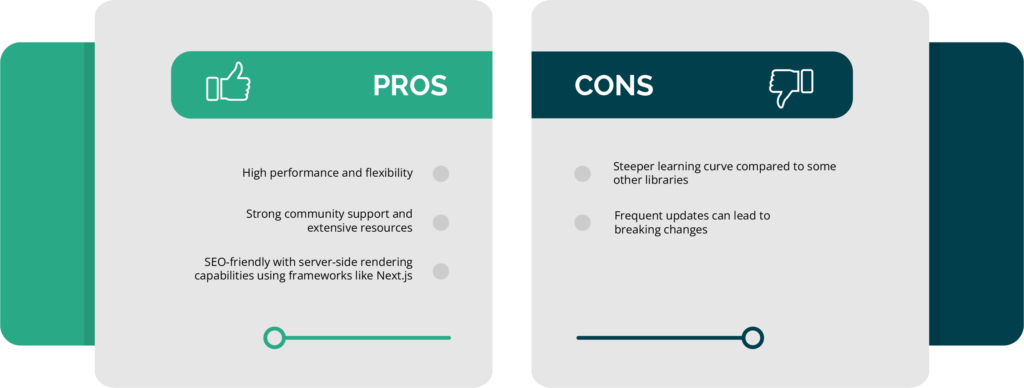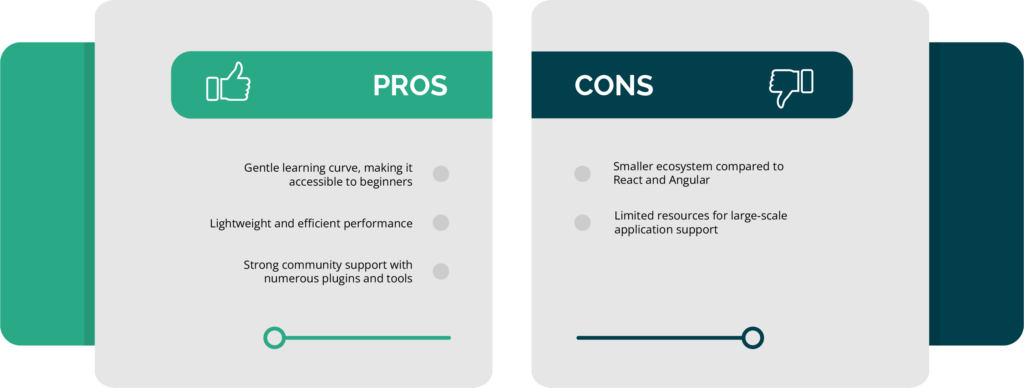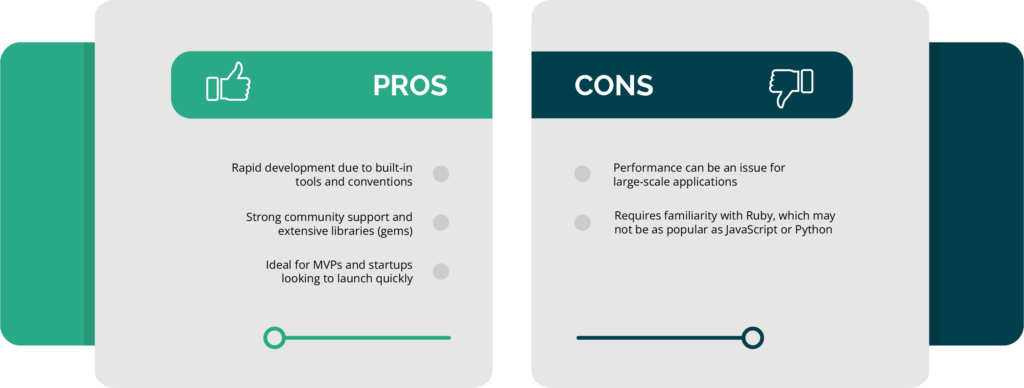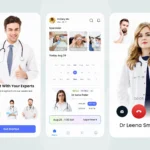Top 5 Best Web Frameworks in 2025
What is a Web Framework?
Why Choosing the Best Web Framework Matters
Features of the Best Web Frameworks
The best web frameworks share several common features that enhance their utility and appeal to developers. These features include:

Image source: Decipher Zone
- Modularity: Frameworks often use a modular architecture, allowing developers to break applications into smaller, reusable components. This makes it easier to manage and update code over time.
- Robust Routing: Advanced routing capabilities enable developers to handle complex URL structures and navigation flows seamlessly, improving user experience.
- Built-in Security: Top frameworks incorporate security measures against common threats such as SQL injection, cross-site scripting (XSS), and cross-site request forgery (CSRF), ensuring that applications are safer from vulnerabilities.
- Comprehensive Documentation: Good frameworks come with extensive documentation, tutorials, and community forums, making it easier for developers to learn and troubleshoot issues.
- Performance Optimization: Many frameworks include features that enhance performance, such as lazy loading, caching mechanisms, and efficient data handling practices, leading to faster application load times and improved responsiveness.
- Scalability and Flexibility: The best frameworks are designed to scale easily with growing user bases and adapt to new features without requiring a complete overhaul of the codebase.
These features collectively contribute to the effectiveness of a web framework, making it a suitable choice for a wide range of applications.
Looking For a Trusted Tech Partner?
We’ll help you decide on next steps, explain how the development process is organized, and provide you with a free project estimate.
Top 5 Best Web Frameworks in 2025
According to the Stack Overflow Developer Survey 2024, React is the most loved web framework, with 67% of developers expressing satisfaction with it. Angular and Django follow closely behind, with satisfaction rates of 60% and 58%, respectively. Furthermore, 55% of developers indicated plans to learn Vue.js in the upcoming year, highlighting its growing popularity among newcomers.
1. React
React is a powerful JavaScript library developed by Facebook, primarily used for building user interfaces, particularly for single-page applications (SPAs). Its component-based architecture allows developers to create reusable UI components that can manage their state efficiently.
Key Features:
- Virtual DOM: React uses a virtual DOM to optimize rendering, improving performance by minimizing direct manipulation of the actual DOM.
- Component-Based Architecture: Components can be reused, making development more efficient and organized.
- Strong Ecosystem: A rich ecosystem of libraries and tools, such as React Router and Redux, extends its capabilities.

Use Cases: Ideal for dynamic web applications, e-commerce sites, and any project requiring a responsive user interface.
2. Angular
Angular is a comprehensive framework developed by Google for building large-scale web applications. It employs a component-based architecture and provides a robust set of tools for creating dynamic applications.
Key Features:
- Two-Way Data Binding: Synchronizes data between the model and the view, allowing for real-time updates.
- Dependency Injection: Facilitates better code organization and testing by managing dependencies efficiently.
- Comprehensive Tooling: Angular CLI (Command Line Interface) simplifies project setup and management.

Use Cases: Best suited for enterprise-level applications, progressive web applications (PWAs), and applications requiring strong scalability.
3. Vue.js
Vue.js is a progressive JavaScript framework that focuses on building user interfaces. It can be easily integrated into projects with other libraries or existing applications, making it versatile and user-friendly.
Key Features:
- Reactive Data Binding: Automatically synchronizes data between the model and the view.
- Single File Components: Combines HTML, CSS, and JavaScript in a single file, promoting organization.
- Flexibility: Can be used for building both SPAs and large-scale applications.

Use Cases: Suitable for small to medium-sized projects, dashboards, and applications that require quick development and iteration.
4. Django
Django is a high-level Python web framework that encourages rapid development and clean, pragmatic design. It follows the “batteries included” philosophy, providing a wide range of built-in features.
Key Features:
- Admin Interface: Comes with a customizable admin panel for easy content management.
- Robust Security Features: Includes protection against common vulnerabilities like SQL injection and cross-site scripting (XSS).
- ORM (Object-Relational Mapping): Simplifies database interactions with Python objects.

Use Cases: Ideal for content management systems (CMS), data-driven applications, and projects requiring strong security features.
5. Ruby on Rails
Ruby on Rails (often referred to as Rails) is a web application framework written in Ruby. It emphasizes convention over configuration, enabling rapid development and easy maintenance.
Key Features:
- Active Record: Simplifies database interactions with an intuitive syntax.
- Convention over Configuration: Reduces the number of decisions developers need to make, speeding up development.
- Integrated Testing Framework: Supports test-driven development (TDD) practices.

Use Cases: Best for startups, MVPs, and web applications that prioritize rapid development and prototyping.
Have a Project Idea in Mind?
Get in touch with Savvycom’s experts for a free consultation. We’ll help you decide on next steps, explain how the development process is organized, and provide you with a free project estimate.
Key Considerations When Choosing a Web Framework
Selecting the best web framework is a foundational decision that can determine the efficiency, security, and long-term success of a web project. With numerous options available, understanding the core factors that align with your unique business needs is essential. Here are some key aspects to consider:
-
Project Requirements: The best web framework should align with your specific functional and non-functional requirements, such as performance, scalability, and security. For instance, if you’re building a real-time application with extensive I/O operations, frameworks like Node.js, known for its event-driven architecture, may suit your needs better. Alternatively, for data-heavy applications, Django’s ORM (Object-Relational Mapping) provides seamless database management, making it ideal for projects that require robust data handling capabilities.
-
Team Expertise and Learning Curve: An effective web framework selection process should involve assessing your development team’s familiarity with the technology. Opting for a framework that matches the team’s skills will enhance productivity and reduce ramp-up time. If your team is experienced in Python, Django or Flask may be more efficient choices. For teams comfortable with JavaScript, frameworks like React or Vue offer a smooth transition and leverage the team’s expertise to minimize the learning curve.
-
Community and Resources: A framework with a large, active community offers invaluable support and resources. The best web framework options, such as React or Angular, come with extensive documentation, numerous third-party plugins, and forums where developers discuss solutions to common challenges. Access to a strong support network also provides peace of mind that the framework will be reliable, with a wealth of resources to address both technical issues and best practices.
-
Performance and Scalability: Consider the performance implications of each framework, especially if your application is expected to scale. Frameworks like Django, which easily integrates with caching systems, and Node.js, known for its asynchronous, non-blocking operations, are both strong choices for scalability. High-performance frameworks prevent bottlenecks, handle increased traffic efficiently, and support the future growth of your application without the need for extensive reworking.
-
Future-proofing: A framework’s longevity and ongoing support are critical for long-term viability. Choose a framework that is actively maintained and has a clear roadmap for updates, ensuring compatibility with emerging technologies.
Frameworks like Laravel and Ruby on Rails, for example, provide regular updates and continuous community contributions, which are essential for ensuring that your application remains current with security patches, improved performance, and evolving standards. When partnering with an experienced Laravel development company, businesses can leverage this framework’s robust ecosystem and long-term support to build scalable, maintainable applications that adapt to future technological requirements.Similarly, Ruby on Rails offers a convention-driven architecture, rapid development capabilities, and a mature ecosystem that helps businesses launch features faster while maintaining clean, secure code. A list of Ruby on Rails development companies that can help you leverage the full potential of the framework and ensure long-term application sustainability.
By carefully evaluating these factors, businesses can confidently select the best web framework to build a reliable, scalable, and efficient application tailored to their goals and technical environment.
Popularity Trends
Understanding popularity trends in web frameworks can offer insights into their staying power, community support, and future development direction. Here’s a look at some of the most widely adopted frameworks:
- React: React has consistently been a top choice for front-end development, favored for its flexibility, component-based architecture, and support for modern web standards. Its popularity is driven by its large community, continuous improvements, and the backing of Facebook, which has kept it up-to-date with the latest developer needs. React’s ability to efficiently manage state and render components dynamically has made it a leader in creating responsive and high-performing web applications. It remains popular for both enterprise projects and startups due to its versatility and performance optimization tools.
- Django: For back-end development, Django continues to be a go-to framework, especially in projects requiring fast turnaround and data-intensive operations. Built on Python, Django excels in rapid development and is known for its security features and built-in admin panel, which makes managing databases seamless. Django’s robustness and scalability are well-suited to complex applications, making it a top choice for e-commerce, financial, and social media platforms. Its focus on the “Don’t Repeat Yourself” (DRY) principle enables developers to work efficiently, reducing redundancy in code.
- Vue.js: Vue.js is quickly gaining traction as a preferred choice for smaller teams and projects looking for a lightweight, flexible front-end solution. Known for its gentle learning curve and simplicity, Vue offers a balance between ease of use and powerful features, making it ideal for both novices and seasoned developers. With extensive documentation and a growing community, Vue has established itself as a favorite for building user-friendly interfaces and interactive applications. While it doesn’t yet have the widespread enterprise adoption of React, Vue’s modular nature and adaptability make it a popular choice for new projects and prototyping.
Keeping an eye on these trends can be helpful when selecting the right framework, especially as project requirements evolve and the web development landscape changes.
Conclusion
As we progress through 2025, the choice of the best web framework can significantly influence the success and scalability of your web applications. Each framework offers distinct advantages tailored to specific use cases, from React’s component-based flexibility to Django’s robust backend capabilities.
When selecting a framework, consider your project’s requirements, the expertise of your development team, and the long-term support and community around the framework. Ultimately, making an informed choice can lead to more efficient development processes, higher quality applications, and greater overall success.
If you’re looking for a software development company that can guide you through the complexities of web app development, Savvycom is ready to help. Our team of experts specializes in creating tailored web solutions that align with your business goals and provide.
From Tech Consulting, Mobile App Development Services, Web App Development Services to #1 Vietnam outsourcing software service! Since 2009, Savvycom has been harnessing digital technologies for the benefit of businesses, mid and large enterprises, and startups across the variety of industries. Savvycom dedicated software development team can help you to build high-quality custom software development services and products as well as deliver a wide range of related professional services.
Savvycom is right where you need. Contact us now for further consultation:
- Phone: +84 24 3202 9222
- Hotline: +1 408 663 8600 (US); +612 8006 1349 (AUS); +84 32 675 2886 (VN)
- Email: [email protected]



